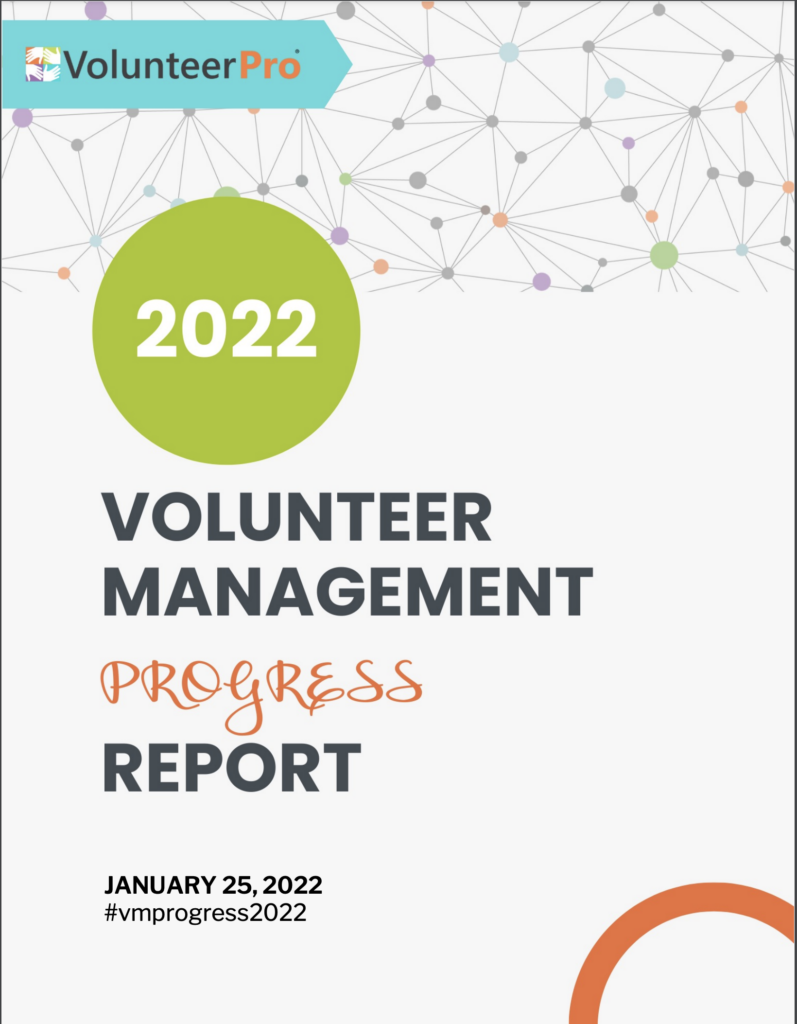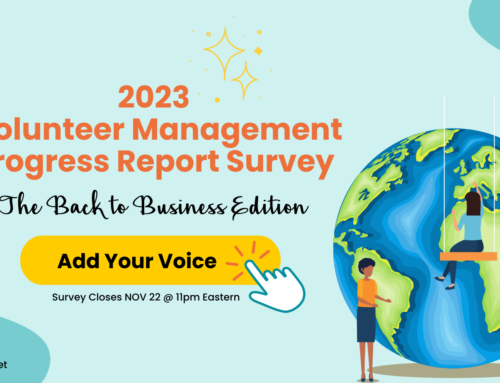Pro Roundup: 7 Years of Volunteer Management Trends & Data
People told us we were nuts when we committed to collecting volunteer management trends every year.
After all, it’s a LOT of work. People also thought the field would tire of sharing their experiences and would lose interest.
But we did it anyway and now report them in our Volunteer Management Progress Report each January.
And that hasn’t been the case. Year after year, the volunteer coordinators from around the world collectively come together to participate in the largest (and longest running) crowdsourcing of volunteer administration data on the planet.
A wide range of distribution partners also help spread the word every Fall when the survey is open for business (the final report is then released early in the year and named for the year it is released).
We appreciate each one of you who have supported and took part in the survey. Without you, we would be unable to track volunteer management trends in a comprehensive way.
In this past two years, volunteerism has been hit hard by the global COVID-19 pandemic, but that’s not the complete story of our evolution as a field of practice.
We are defined by more than the pandemic.
In fact, the past few years of volunteer management trends have revealed even more of who we are at our core.
This year’s global state-of-the-industry report shows that volunteer managers around the world continue to adapt to their new context, seeking new ways to keep the community engaged in service.
Many are also steadily adopting modern technology tools to solve their biggest problems.
This reveals a field of professionals and volunteers with grit, who continue to strive for deeper engagement from communities even when times are tough.
Our data also uncover the painful realities of working in a profession that is often misunderstood and more often under-resourced.
Finally, these reports point to the tremendous untapped potential of volunteers and those who lead and support them.
In times of national and societal division and violence, community cohesion is even more important. Volunteerism and civic engagement are the glue that keeps communities working together toward a common good.
Volunteerism is not just noble, it’s necessary to our survival as a society.
So, it’s vital we continue to understand what we are doing now and what we can do in the future to improve how we involve people in service alongside others who care as much as they do.
Volunteer Management Trends: 7 Years of Data
How has the field of volunteer administration fared over the past seven years? What has stayed the same, even when faced with two years of COVID?
What has changed or evolved over time?
Below, we call out key top line insights from seven years of volunteer management trend data reported in our annual Volunteer Management Progress Report survey.
Visit our research page to download all seven of our Volunteer Management Progress Reports HERE >>
2016: Our Very First Report
Volunteer Managers Feel Undervalued and Under-Resourced
Leading volunteers is both challenging and rewarding. Volunteer coordinators are inspired by volunteers themselves and the job of making a difference. Many volunteer coordinators are seeking an advocate that can help them educate others about their challenges and needs.
Some volunteer administrators feel their work is unfairly undervalued and under-resourced when compared to colleagues with similar levels of responsibility, most notably development or fundraising departments.
Lack of Clear Standards for the Field, but a Clear Connection to Their Cause
Many volunteer managers feel a lack of clear professional identity or standards. They often are charged with a wide variety of roles, in addition to volunteer management, that stretch them in ways that sometimes feel unreasonable.
Volunteerism isn’t just a “feel good add-on” or a community relations exercise for organizations. Leaders of volunteers feel very connected to the cause or organizational identity. They want to solve real community problems and want to hear stories and examples from others so that they can do even better.
2017: A Clearer Picture of the Work & Workload
Volunteer Managers Wear Many Hats
Having sufficient time continued to be a significant challenge for leaders of volunteers. Many reported juggling multiple responsibilities as part-time volunteer managers working in full-time jobs. (Note: This trend has continued throughout seven years of the survey).
In addition, most (57%) were responsible for placing volunteers in other departments within their organizations (most of these large, volunteer involving organizations with over 500 active volunteers per year). Yet 60% had no paid staff that report to them, working as a “department of one.”. With the wide range of tasks necessary, we posed the question – Can comprehensive volunteer administration be effective on a part-time basis?
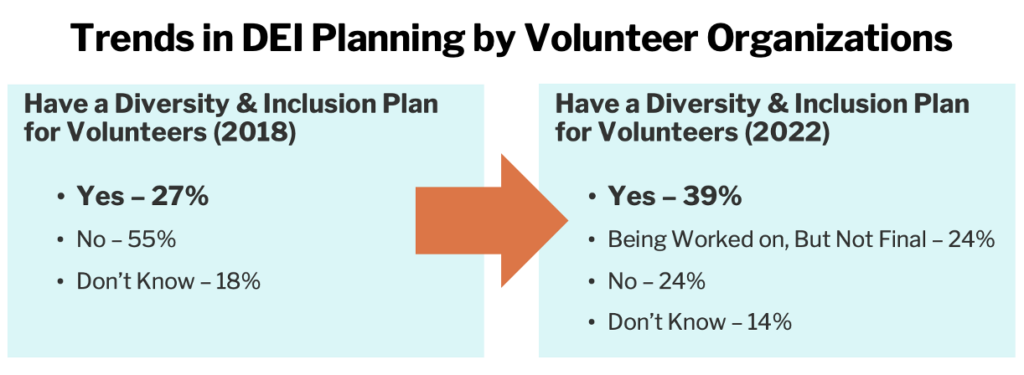 Volunteer Manager Satisfaction and Long-term Tenure
Volunteer Manager Satisfaction and Long-term Tenure
Regardless of the challenges of the job, most leaders of volunteers reported being satisfied with their work, feeling supported by leadership, and noted that they intended to continue working in the field. That said, many noted buy-in and “respect” as a key challenge (16% noted this issue in open-ended comments).
For two years in a row, a substantial number of respondents had more than 20 years of experience in the field – 18% this year and 16% last year. (Note: In each survey, a sizable number of respondents report they have over 20 years working in the field, indicating a depth of institutional knowledge and tradition ant work across the field.)
2018: Early Data on Diversity Equity & Inclusion
Demographics of Volunteer Managers
The demographics of respondents continued to be primarily white (91%) women (91%) and continued to trend this way over three years. The vast majority (78%) had attained at least a bachelor’s degree, consistent with earlier years. (Note: Across seven years, respondents continue to represent an intergenerational group across all age cohorts.)
In comparison, in 2107 people of color represented 36% of the US population. 18% of nonprofit US employees were people of color at that time. (Note: this trend has continued through all seven years of the survey.)
Diversity, Equity, and Inclusion (DEI)
Since the community of volunteer managers taking part in the survey continued to be homogenous, demographically speaking, we also asked about the volunteers they engaged. Nearly half (48%) Strongly Disagree, Somewhat Disagree, or are Neutral that the diversity of their current volunteer corps matches the community they serve (race/ethnicity, language, disability, sexual orientation, citizenship status, etc.).
Over half (55%) of respondents did not have a written diversity and inclusion plan for volunteers; another 18% did not know whether a plan was in place. When we asked in 2022, In our 2022 Volunteer Management Progress Report, 39% reported having a DEI plan in place that includes volunteers, an increase of 12% over four years. Another 24% reported that their DEI plan was Being Worked on, But Not Final yet. 14% did not know whether their organizations had a plan in place to ensure diversity, equity, and inclusion in volunteerism.
2019: The Tech Edition
The Need for Digital Skill-building and Tech tools
Comfort with digital tools was ranked significantly lower, when compared to competence with general volunteer resource management skill areas. The mean across all the competencies was 2.53, falling between Beginner and Competent. While for general skills, the mean was 3.61, between Competent and Proficient.
We also asked respondents to share which volunteer management platforms they used and whether they recommended them using the Net Promoter Score metric (an often-used way to track customer loyalty and profitability in the private sector).
For respondents with volunteer management software, the NPS was 0. The aggregate for all solutions, including Excel spreadsheets and no software at all was -23. The industry average at the time for software and smart phone apps ranged from 28 to 41, indicated low satisfaction with volunteer management software.
Buy-In and Reliable Internal Support Continues to Be an Issue
Respect and buy-in from executive leadership and co-workers and reliability continued to be the greatest obstacles to success for leaders of volunteers.
When asked to share their #1 biggest challenge they mentioned recruitment (33%) and respect and buy-in (13%) as top issues year over year, pointing to a frustration with the ability influence as a middle manager.
We posed the question – How does the lack of respect and resources affect the ability to volunteer services to fill needed roles? Is retention (ranked third in biggest challenge that year) also affected, creating a cycle of volunteer turnover?
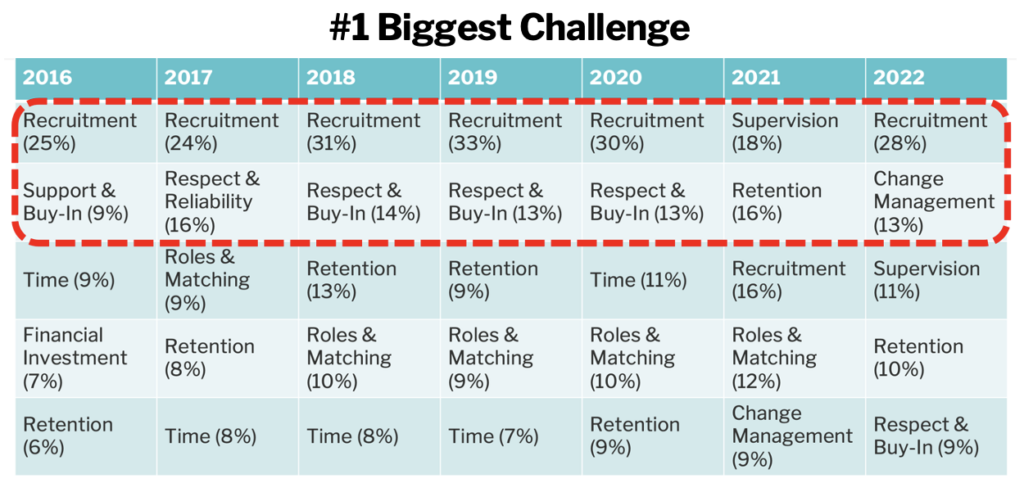 2020: The Benchmarking Edition
2020: The Benchmarking Edition
Correlations Between Impact and Practice
In our 2020 report, we decided to dig into volunteer management trends around impact. We found interesting correlations between program budgets, staff credentials, specific volunteer requirements, and management methods. While there are a variety of variables that contribute to the success of an organization’s volunteer engagement strategy, these may have implications for practice.
While this type of research cannot claim cause and effect relationships, these comparisons offer organizations clues on where to focus their management interventions in areas that may have a higher probability of success.
Volunteer Manager Job Titles, Supervisory Loads, and Salaries
Those who lead volunteers go by many job titles, with Coordinator appearing as the most common. The top three words included in the job titles of respondents were: Coordinator 38.3%, Manager 26.9%, and Director 16.3%. (Note: volunteer Coordinator continued to be the most often used title to describe the work of leaders of volunteers.)
To better understand supervisory loads, we asked for the minimum and maximum number of volunteers supervised. The average for minimum number reported was 6-10 volunteers, and the average maximum number 21-50 volunteers.
Reported volunteer manager salaries ranged from an average of $43,609 USD per year for nonprofit employees, to an average of $54,313 for government employees, to an average of $56,642 for church and congregation employees. The average overall salary in the US was $45,475.
Also, there was a correlation between average salary and job title, with some job titles receiving more on average than others.
2021: The COVID Edition
Impact of COVID on Volunteer Participation
In the first year of the pandemic, COVID had a devastating impact on volunteer participation across organizations. Volunteer managers reported fewer volunteer opportunities available, fewer volunteers contributing time, and those who were active contributing fewer hours.
These data represent a potential “triple threat” for volunteer organizations as they seek to build back capacity of their volunteer workforce and their ability to meet goals and aims that are mission critical.
(NOTE: This drop in volunteer engagement continued into the second year of the pandemic.) The question is still – What long-term impact will COVID have on volunteer participation around the world? And are volunteer organizations equipped and ready to conduct the massive outreach efforts needed to recoup these losses?
Time Devoted to Volunteer Management
In this report, we saw a general erosion in time devoted to volunteer management as a part of the leader of volunteer’s workload. Less than half (47%) devote 75% or more of their time to volunteer engagement. While this year may have been an anomaly, with volunteer managers helping with other tasks, as needed, this is a troubling trend.
Volunteer managers continue to “wear many hats,” despite the complex array of duties and tasks needed to support a robust volunteer effort. This leads us to question whether volunteer organizations are currently making the most of volunteer potential latent in their communities.
(Note: The following year there was a rebound in the percentage of leaders of volunteers that spent most of their time on volunteer administration tasks. 52% reported they devote at least three-quarters of their work schedule to volunteer management.)
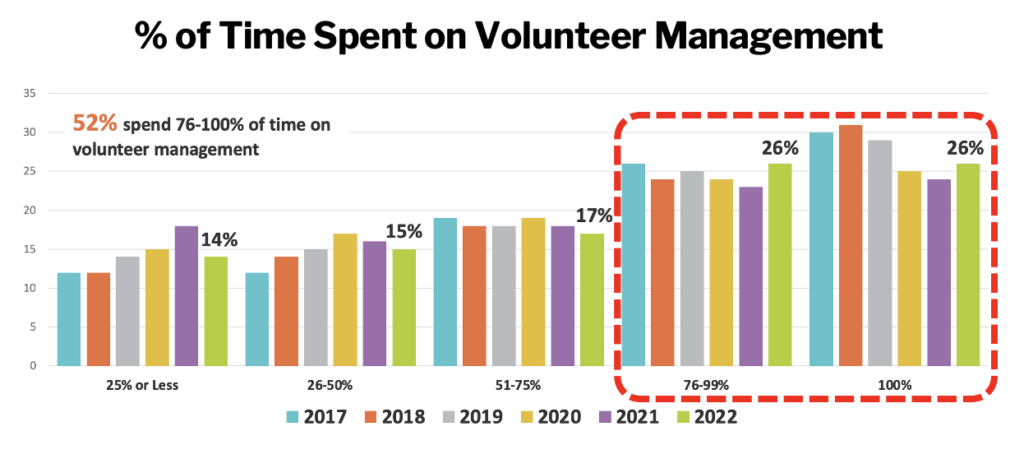 2022: The Second Year of COVID
2022: The Second Year of COVID
Level of Burnout in Leaders of Volunteers
While many volunteer coordinators expressed experiences of fatigue, frustration, and burnout in the open-ended comments of this survey, results from burnout self-assessment questions showed limited sign of the key indicators of burnout (occupational depletion or exhaustion, cynicism, and reduced professional efficacy.
Recent research on employee burnout, however, shows a more nuanced picture of the warning signs, which we were unable to explore fully. So, it’s not clear if the field is at risk and which direction we may be trending.
Use of Technology by Volunteer-Involving Organizations
Despite lockdowns, organizations have not embraced the full potential of remote or virtual roles (offering 25% or less volunteer roles over the past two years), and fewer volunteer managers rate their agencies as digitally mature, down 6% from last year.
As the world evolves, so too must volunteerism. While organizations are advancing in their technology use, it’s not clear if they will keep pace, or risk losing valued community support due to lack of effective use of technology.
For more on insights shared by Season 3 Time + Talent Podcast guests and inside our VolunteerPro Insiders group on Facebook, check out Our 7 Top Volunteer Management Trends for 2022 HERE >>
Ready for More Volunteer Management Trends?
If there is any benefit at all to COVID, it is this – long-held limiting beliefs are being challenged and new ways of doing are now being embraced for the better. For those who are taking the leap forward, their missions will no doubt benefit.
If you’re curious about how the field ins adapting and evolving, check out our 2022 Volunteer Management Progress Report. It reflects the experiences of over 1,300 volunteer administrators from 24 countries around the world.


